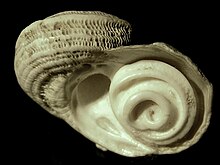
Back Оперкулум (мекотели) Bulgarian Opercle (gasteròpodes) Catalan Operkulum Czech Operculum German Επιπωμάτιο (γαστερόποδα) Greek Opérculo (gasterópodos) Spanish Opercule (mollusque) French Opérculo (gasterópodos) Galician Opercolo Italian Operkulas Lithuanian


An operculum (Latin for 'cover, covering'; pl. opercula or operculums) is a corneous or calcareous anatomical structure like a trapdoor that exists in many (but not all) groups of sea snails and freshwater snails, and also in a few groups of land snails; the structure is found in some marine and freshwater gastropods, and in a minority of terrestrial gastropods, including the families Helicinidae, Cyclophoridae, Aciculidae, Maizaniidae, Pomatiidae, Neritidae etc.
The operculum is attached to the upper surface of the foot and in its most complete state, it serves as a sort of "trapdoor" to close the aperture of the shell when the soft parts of the animal are retracted. The shape of the operculum varies greatly from one family of gastropods to another. It is fairly often circular, or more or less oval in shape. In species where the operculum fits snugly, its outline corresponds exactly to the shape of the aperture of the shell and it serves to seal the entrance of the shell.
Many families have opercula that are reduced in size, and which are not capable of closing the shell aperture. Opercula have sometimes been modified: in the Strombidae the operculum is claw-shaped and is used to push into the substrate in a leaping form of locomotion.
Virtually all pulmonate snails are inoperculate, i.e. they do not have an operculum, with the exception of the Amphiboloidea. However, some terrestrial pulmonate species are capable of secreting an epiphragm, a temporary structure that can in some cases serve some of the same functions as an operculum. The epiphragm may be distinguished from the true operculum by its homogeneity and want of growth marks.
In ammonites (extinct shelled cephalopods), a calcareous structure known as the aptychus (plural aptychi) existed. When these were first described they were thought to be valves of a bivalve species, then for many years after that they were considered to be a form of paired or single operculum-like structures belonging to ammonites. More recently the aptychus or paired aptychi have been hypothesized to be a jaw apparatus of ammonites.